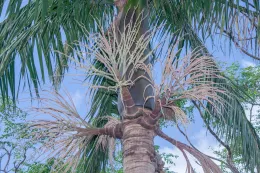2017 Articles:

The polyphagous shot hole borer (now called invasive shot hole borer) and its vectored fungal disease complex have been attacking a wide variety of trees in southern California for several years, including landscape trees and some palms, avocado groves, and native species in urban and wild land settings. With a host range of over 200 woody species, the polyphagous shot hole borer is an invasive, wood-boring, ambrosia beetle in the genus Euwallacea. It bores into trunks and large branches, making tunnels or galleries where it lays eggs and can infect the host with a pathogenic fungal complex that is a food source for the developing larvae. Here I provide an illustrated overview of the pest and its vectored disease on palms, including their history, pest description and damage, host palm species, and management strategies. DOI: https://doi.org/10.21414/B11P4C

This article discusses and illustrates a trip to the Ryukyu Islands, Kyushu, Kyoto, and Tokyo, Japan in 2013 to search for wild and cultivated palms (Arecaceae) as part of a larger project to document Pacific island palms. Palms in the wild that we saw included Satakentia liukiuensis, Arenga ryukyuensis, and Livistona chinensis. DOI: https://doi.org/10.21414/B1WW2F

This article discusses and illustrates a trip to the Ogasawara Islands, Japan in 2014 to search for palms (Arecaceae), primarily the wild Clinostigma savoryanum and Livistona boninensis, and the escaped Arenga engleri, as part of a larger project to document Pacific island palms. DOI: https://doi.org/10.21414/B1S59X

This article illustrates and discusses an unforgettable helicopter adventure to the spectacular Fulaga Lagoon, Southern Lau Group, Fiji to see Pritchardia thurstonii (Arecaceae) in a stunning, breathtaking habitat on top of small. mushroom-shaped, karst limestone rock islets. This trip was part of a larger project to document Pacific island palms. DOI: https://doi.org/10.21414/B1NC70

Over the last three years, collectors in southern California are reporting and posting on social media about a serious and unusual malady of plumerias, primarily Plumeria rubra, where leaves become discolored and deformed. The cause of this serious malady is a leafhopper in the genus Empoasca, which we have detected, often in abundance, on numerous, afflicted plumerias. This Plumeria leafhopper is perhaps the greatest calamity to befall plumerias in the history of these plants in California. Here we provide a summary of its history in southern California, symptoms, identification and biology, and possible management strategies. DOI: https://doi.org/10.21414/B1HP4Q
